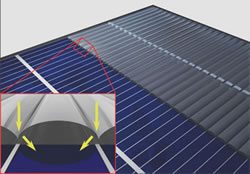Cloaking Principle Could Boost Solar Cell Performance
 Invisibility cloaking may be a long way from reality, but the principle could help improve the performance of solar cells in the near term.
Invisibility cloaking may be a long way from reality, but the principle could help improve the performance of solar cells in the near term.
In a series of simulations, researchers at the Karlsruhe Institute of Technology have demonstrated how cloaks made of metamaterials or freeform surfaces could eliminate shadows cast by energy-harvesting components onto the active surfaces of solar cells.
Contact fingers, which extract electric current, cover up to one-tenth of the surface area of a solar cell. By guiding light around these features, more of the sun's energy could be captured by the solar cell.
"Our model experiments have shown that the cloak layer makes the contact fingers nearly completely invisible," said doctoral student Martin Schumann. Cont'd...
Comments (0)
This post does not have any comments. Be the first to leave a comment below.
Featured Product

